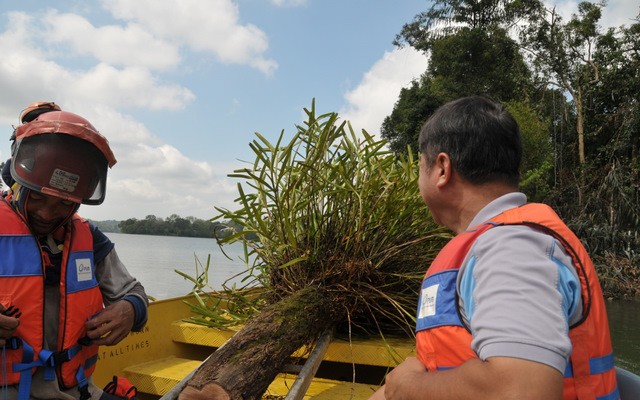From Destruction Comes Rediscovery
Every dark cloud has a silver lining, as the Nature Conservation team from the National Parks Board (NParks) found out.
On the evening of 11 February 2011, an intense localised storm struck the Mandai forest north of Upper Seletar Reservoir. More than 30 hectares of forest were severely damaged - trunks and branches were snapped, with many big trees uprooted. Subsequent aerial photographs taken by the National Biodiversity Centre and Singapore Polytechnic painted a sombre picture of the damage.
A few days after the storm, a survey of the damage along the reservoir was made using a boat arranged with the PUB's Water Department. The scene that unfolded seemed unforgivably endless.
A jewel of a find among the gloom
Suddenly, Derek, a member of our survey team, shouted for the boat to go nearer the edge. He had spotted something with his binoculars. Upon closer inspection, he saw it was a clump of orchids growing on an uprooted silverback tree. A cutting of the orchid was quickly sent to the Herbarium of the Singapore Botanic Gardens for identification.
A rare rediscovery
Singapore's native orchid species number less than 230, with more than 75 percent of these listed in the Singapore Red Data Book as Nationally Extinct. Thus we became very excited when we realised the orchid was one thought to be such - Bromheadia alticola, an epiphytic orchid that typically forms a large clump of about 1.5 metres in diameter on the trunks of the loftiest trees. It was last collected in the 1890s by the Gardens' first director, Mr H. N. Ridley.
As the orchid was not in flower then, and its flower was required to confirm its identity, another boat trip was arranged, this time with the herbarium staff on board. This species was reported to flower about 10 days after a stimulus of a sudden drop in temperature, such as a thunderstorm. However, the second trip missed the flowering by a few days. Even so, a single faded flower was found which helped to confirm the species' identity.

The whole clump of Bromheadia alticola still rooted to the fallen silverback tree was transported to MacRitchie Reservoir to improve its chances of survival.
We decided to transplant the whole clump to MacRitchie Reservoir as it was unhappily perched on the silverback tree, fully exposed to direct sunlight. To our relief, it has since flowered a few times in its new location.

The clump of orchids can grow as large as 1.5 metre in diameter, as can be seen in this picture of it at MacRitchie Reservoir, with Derek Liew standing next to it.
What the future holds for Bromheadia alticola
The sweetly-scented flowers are white with a yellow lip fringed with purple. Flowering is sudden and profuse, but ephemeral, such that a well-grown clump will exhibit many short-lived flowers that open early in the morning and start to close up when the sun is high in the sky.

Bromheadia alticola occasionally bear two flowers.
As part of an ongoing conservation and reintroduction project, we are trying to propagate the species by vegetative propagation and from seeds. Seed capsules have been collected and brought back to the laboratory. If the seeds germinate successfully, we should be able to reintroduce the species back into our forests in two to three years time.
We are also studying the possibility of introducing the species to streetside trees that offer the right conditions for it to grow. As this orchid has the same gregarious flowering characteristics of the pigeon orchid, we hope it will add variety to showcasing our native orchids along Singapore's streets.
| Glossary Ephemeral: A plant or flower with a short life cycle. Epiphytic Orchid: An orchid that perches on another plant for support, but does not derive nourishment from it. Inflorescence: A flowering structure that consists of more than one flower. Gregarious Flowering: Refers to the simultaneous flowering of all the plants of the same species, spread across a wide geographical area. Nationally Extinct: Refers to native plants species that have not been recorded in Singapore's forests for 30 years. |
By Dr Yam Tim Wing, Paul K.F.Leong, Derek Liew, Chew Ping Ting, William Ng, and Sunia Teo.
Pictures by Dr Yam Tim Wing and Derek Liew.



Have views or comments on this article? Let us know via this form. If you would like to give us feedback on any other areas relating to our parks and gardens, please submit via https://www.nparks.gov.sg/feedback